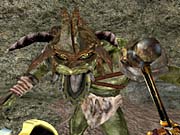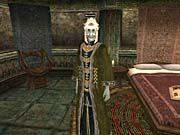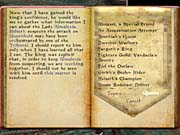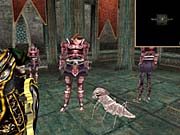Even though they are becoming increasingly common, expansion packs for role-playing games don't generally offer a rewarding experience for anyone other than the most devoted fans of the original game. By the end of a role-playing game, your character has typically developed great abilities and explored vast territories in order to dispatch a nigh invincible foe in an epic confrontation. Most RPGs offer sufficient closure in this regard, so expansion packs often end up diluting the original experience by tacking on a few anticlimactic quests and offering several new absurdly powerful magic items that unbalance the gameplay. The Elder Scrolls: Tribunal avoids most of these problems by offering an experience that is both sufficiently novel and interesting and yet also integrates well into the Elder Scrolls setting.

Recently, RPG developers have become more adept at making worthwhile expansion packs. Diablo II: Lord of Destruction improved the graphics of the original game, offered new and diverse characters, and concluded the main plot of the series. Baldur's Gate II: Throne of Bhaal was even more satisfying, since it offered a lengthy plot that logically concluded that series of games. Those expansion packs were so successful because they sensibly expanded upon and resolved the plots of the original games, while previous RPG expansions had just tossed in a few extra quests that didn't necessarily resolve the main series' plot. Tribunal, on the other hand, makes a compromise by letting you explore its areas either before or after resolving Morrowind's main plot. Since Tribunal's plot ties in well with the lore revealed in the original game, it's a design approach that works reasonably well, even though a direct continuation of Morrowind's main plot would probably have been more satisfying.

Tribunal is set entirely in Mournhold, the capital city of the Imperial Province of Morrowind. Mournhold and its political intrigues were frequently described by characters and texts in the original game. The royal family of Mournhold was the subject of several books that could be found in Morrowind, and the recently deceased former monarch was a member of one of the three dark elf "great houses" your character could join. Finally, Mournhold is also the residence of Almalexia, one of the three mortal heroes who created the tribunal after ascending to divinity. Since one of the most appealing aspects of the original game was exploring its expansive geographical areas, it's somewhat surprising that the Tribunal expansion confines your adventures to the relatively small setting of the municipality. The city contains the royal palace and four separate districts, each of which only consists of a handful of buildings or landmarks, and the entire area is populated by only a few dozen non-player characters--while the original game had more than 2,000 NPCs. However, there are plenty of things to do in the more-confined setting, because virtually every character you meet plays a role in one or more quests. While the original game offered a fairly free-form world to explore, Tribunal provides a more-focused, story-driven experience, which may disappoint players looking for more open-ended exploration.
The events in Tribunal revolve around unveiling the true nature of the threat spawned by the simmering rivalry between the Imperial Monarchy and Almalexia. The main plot is conveyed through solving quests for one or both of those rivals, and scripted events are used more frequently and effectively in Tribunal than in Morrowind. There are also quite a few ancillary quests, several of which have goals that are more novel than the standard "fetch this" or "kill this monster" quests in the original game.
In The Elder Scrolls III: Tribunal, you'll get the opportunity to play at being a matchmaker, spy on the unfaithful, and even assume a dramatic role in a rendition of a play that was referred to in the original game. The expansion's quests are generally quite involved, although it's disappointing that there are no additional guild or faction quests and that Morrowind's main themes, such as the return of sixth house and the disappearance of the dwarves, aren't advanced in any material way. There are a number of gameplay improvements that can be carried over to the main game, but otherwise, Tribunal is a separate and discrete experience.

The graphics in Tribunal are on par with the excellent visuals in the original game, but the expansion's sound effects and music are less memorable. Then again, since most of Tribunal is set in relatively enclosed environments, the game generally runs more smoothly and at higher frame rates. The ability to add notes to maps improves an already excellent auto-mapping feature, and the journal has now been reorganized to let you quickly view all relevant notes for each quest. If you've explored a lot of the main game already, it can take almost an hour when you first install the game to reorganize the journal notes by quests. The revised journal didn't correctly note the completion of a few older quests, but it greatly enhances the journal's utility overall. Like several of Tribunal's enhancements, it's a feature that will be better appreciated by those who haven't already played through the main game.
In addition to offering more-useful note-taking and mapping functions and providing a more story-driven experience, Tribunal addresses some of the original game's issues. An advanced character who has completed Morrowind and is equipped with powerful artifacts and maximized attributes will be able to quickly advance through Tribunal's areas, but the expansion is still definitely more difficult than the original game, even without adjusting the difficulty slider that was added in a game patch. The expansion also adds several new monster types, as well as a few more-difficult adaptations of creatures from the original game. In addition to the new fauna, Tribunal provides several new flora types and new alchemy ingredients. Tribunal is still a single-character game, but you can now hire a mercenary companion, and the followers are now much quicker and more capable of tracking your movements. You can also purchase a few pets, including pack rats capable of lugging loot around for you. There are three different types of pets, and you can have up to three of each of them with your character, which actually lets you assemble quite a troop, especially since you can also have several human companions join you. However, it's difficult to keep the whole party assembled, even with the expansion's improved companion pathfinding. Scribs, which are the most entertaining pets, consistently get lost in deep water, so they're better suited to traveling through the open territories of the main game than the waterlogged dungeons in Tribunal.

Judged as a stand-alone product, Tribunal doesn't have many of the features that made Morrowind so appealing. It's more linear, it's less open-ended, and it doesn't offer faction and guild quests so you can role-play a variety of character types. On the other hand, it offers more-complex story-driven quests, a plot that ties in well with the setting's established lore, a greatly improved journal, and the opportunity to assemble a group of adventuring companions. When combined with the original game, The Elder Scrolls III: Tribunal's features make an excellent role-playing game even better.